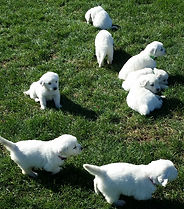

Golden Retrievers of Foxwater Farm

Early Neurological Stimulation for Puppies (ENS)
Our ultimate goal is to provide our forever families with the best puppies possible. This means only breeding physically and mentally sound, loved pets and introducing our puppies from day 3 to countless sounds, volumes, textures, animals, stimulations, experiences and fun! A well socialized puppy is not only healthier and happier; it makes for the perfect pet!
From research after years of results by the U.S. Military Canine Program, we know that the interval of time between day 3 and 16 is the most crucial window of time for the rapid development and growth of the neurological system in puppies. For these first few days, these very young puppies’ eyes are closed and they are only able to suck, smell, and crawl. To encourage our puppies neurological growth and development, we follow a program created by the military called “Bio-Sensor” or later termed “Super Puppy” training which according to studies will give dogs a superior advantage in life.
Documented Benefits of Early Neurological Stimulation:
Improved cardio vascular performance
Stronger heart beats
Stronger adrenal glands
More tolerance to stress
Greater resistance to disease
Tests proved these “Super Puppies” were found to be more active and more exploratory than non-stimulated puppies. It was also noted that the non-stimulated pups became extremely aroused, whined, and made many errors when put under pressure. The puppies that received Early Neurological Stimulation were less upset by stress conditions. They found the ENS puppies were calmer, made fewer errors and gave only an occasional distress sound when stressed.














Puppy Socialization
From day 16 until the day the puppy goes home, we work daily on socialization with all of our puppies. We strive to raise puppies that are well adjusted and exposed to as many situations as possible. Starting at 4 weeks of age, we begin at least weekly field trips. The puppies are “loved on” by people of all ages. Our obstacle course also begins at 4 weeks. This encourages the puppies to explore their surroundings and challenge themselves. We constantly change textures the puppies feel with their paws and introduce the puppies to strains and other challenges.
Puppy Temperament Testing
Ensures we pick the best home for each of our puppies.
Some of the tests we use were developed as long ago as the l930’s for dogs bred to become Guide Dogs. Then in the 1950’s, studies on puppies were done to determine how quickly they learned. These studies were actually done to identify children’s learning stages.
Top Dog Tips: The ideal age to test the puppy is at 49 days of age when the puppy is neurologically complete and it has the brain of an adult dog. With each passing day after the 49th day the responses will be tainted by prior learning. These tests determined that it was indeed possible to predict future behavioral traits of adult dogs.
We took these tests, added some of our own, and put together what is now known as the Volhard Puppy Aptitude Test, or PAT. PAT uses a scoring system from 1-6 and consists of ten tests. The tests are done consecutively and in the order listed. Each test is scored separately, and interpreted on its own merits. The scores are not averaged, and there are no winners or losers. The entire purpose is to select the right puppy for the right home.
The tests are as follows:
1. Social Attraction - degree of social attraction to people,
confidence or dependence.
2. Following - willingness to follow a person.
3. Restraint - degree of dominant or submissive tendency, and
ease of handling in difficult situations.
4. Social Dominance - degree of acceptance of social dominance
by a person.
5. Elevation - degree of accepting dominance while in a position
of no control, such as at the veterinarian or groomer.
6. Retrieving - degree of willingness to do something for you.
Together with Social Attraction and Following a key indicator for ease or difficulty in training.
7. Touch Sensitivity - degree of sensitivity to touch and a key
indicator to the type of training equipment required.
8. Sound Sensitivity - degree of sensitivity to sound, such as
loud noises or thunderstorms.
9. Sight Sensitivity - degree of response to a moving object,
such as chasing bicycles, children or squirrels.
10. Stability - degree of startle response to a strange object.
During the testing make a note of the heart rate of the pup, which is an indication of how it deals with stress, as well as its energy level. Puppies come with high, medium or low energy levels. You have to decide for yourself, which suits your life style. Dogs with high energy levels need a great deal of exercise, and will get into mischief if this energy is not channeled into the right direction.
Finally, look at the overall structure of the puppy. You see what you get at 49 days age. If the pup has strong and straight front and back legs, with all four feet pointing in the same direction, it will grow up that way, provided you give it the proper diet and environment in which to grow. If you notice something out of the ordinary at this age, it will stay with puppy for the rest of its life. He will not grow out of it.









